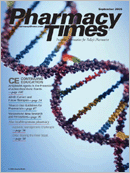Publication
Article
Pharmacy Times
Compounding for Pediatric Patients
Author(s):
Whereas compounding always is a rewarding and challenging realm of pharmacy practice, perhaps some of the most interesting and creative compounds are preparations for pediatric patients. As many parents can attest, getting a child to take medication can be problematic at times, but most compounding pharmacists have an arsenal of trade secrets to make administration easier, thus increasing compliance.
With pediatric patients, commercial dosage forms can be limiting. Children often do not learn to swallow tablets and capsules until they are school-aged, and sometimes commercially available dosage forms can be unpleasant or ill-tasting. In some cases, the commercial market simply provides no options, as with medications that are available only in pill form. In such situations, compounding pharmacists can provide appropriate dosage alternatives, which may include the following1:
- Suspensions
- Solutions
- Emulsions
- Transdermal preparations
- Lollipops
- Gummies
- Rapid-dissolve tablets
- Suppositories
One of the most widely used pediatric dosage alternatives is transdermal gel for nausea and vomiting. No patient likes to use a suppository if it can be avoided, and compounding provides options where commercial medicine leaves a gap. For example, promethazine is a frequently used medication for symptoms of nausea and vomiting. It can easily be incorporated into a topical preparation, which is rubbed into the wrists or other thinskinned areas.2 For patients under the age of 2 years, many physicians prefer trimethobenzamide for nausea, which can be prepared in a similar vehicle. These dosage forms carry the same side effects of drowsiness as their oral and rectal counterparts, but they are much easier to use and absorb quickly into the system. Dispensing may be done in unitdose or multidose topical syringes.
Another frequent symptom found in childhood illnesses is sore throat, which often occurs with tonsillitis, with a streptococcus infection, or with a viral infection. In such cases, tetracaine lollipops are a popular choice of many patients and their parents. These lollipops can be prepared in various sizes to accommodate all ages, and medication strength varies from 0.5% up to 4%, depending on the condition of the patient. Higher strengths usually are reserved for older postsurgical patients.
Flavoring bitter, salty, or sour-tasting medications also is a frequent request, and most experienced compounders can make even metronidazole palatable.3 Many pharmacies carry a wide variety of flavors, and children usually enjoy selecting their favorites from the menu.
Diaper rash is another common pediatric condition, and compounding pharmacists often can help when OTC medications fail to alleviate symptoms. A popular choice among pediatricians for persistent diaper rash, particularly that associated with diarrhea, is cholestyramine ointment. It is prepared in a petrolatum (eg, Aquaphor) or hydrophilic ointment base and works by binding up the bile acids that cause the redness and irritation.4,5
For pediatric dental patients, a sedative compound sometimes is prescribed prior to dental procedures. Such compounds, either alone or in various combinations, may include chloral hydrate, diazepam, hydroxyzine, meperidine, midazolam, or promethazine. Each preparation is custom-made to the physician's specifications to meet the needs of the individual patient. These components can be prepared in a singledose, flavored-suspension "cocktail" or as a rapid-dissolve tablet. They generally are administered 30 to 60 minutes prior to dental procedures.
Topical anesthetics are a frequently requested item for many physicians in office and hospital settings. A topical gel such as lidocaine/epinephrine/tetracaine often is used in hospital settings and emergency departments to numb the skin for injections, drawing blood, or stitching wounds.6 Another popular preparation is benzocaine/lidocaine/ tetracaine gel, which may be used prior to minor in-office procedures such as ear piercing or immunizations to reduce discomfort and anxiety.
It is clear that the pediatric population has very specific therapeutic needs, which cannot always be met by commercially available medications. An innovative compounding pharmacist can provide alternatives with specialized dosing and flavoring to meet the needs of individual patients.
This article was contributed by: International Journal of Compoundingand CompoundingToday.com
Ms. Fields is with the International Journal of Pharmaceutical Compounding and is a pharmacy technician at Innovative Pharmacy Services in Edmond, Okla.
For a list of references, send a stamped, selfaddressed envelope to: References Department, Attn. A. Rybovic, Pharmacy Times, Ascend Media Healthcare, 103 College Road East, Princeton, NJ 08540; or send an e-mail request to: [email protected]

Newsletter
Stay informed on drug updates, treatment guidelines, and pharmacy practice trends—subscribe to Pharmacy Times for weekly clinical insights.






